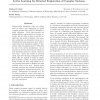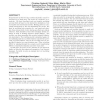1660 search results - page 67 / 332 » A Behavior Model for Next Generation Test Systems |
ICML
2009
IEEE
15 years 6 months ago
2009
IEEE
Physics-based simulation codes are widely used in science and engineering to model complex systems that would be infeasible to study otherwise. Such codes provide the highest-fid...
TAICPART
2006
IEEE
15 years 5 months ago
2006
IEEE
The design of complex systems, e.g., telecom services, is nowadays usually based on the integration of components (COTS), loosely coupled in distributed architectures. When compon...
ISWC
2005
IEEE
15 years 5 months ago
2005
IEEE
Children with autism often exhibit self-stimulatory (or “stimming”) behaviors. We present an on-body sensing system for continuous recognition of stimming activity. By creatin...
113
click to vote
SCESM
2006
ACM
15 years 5 months ago
2006
ACM
Requirements models for large systems typically cannot be developed in a single step, but evolve in a sequence of iterations. We have developed such an iterative modeling process ...
122
click to vote
NN
2002
Springer
14 years 11 months ago
2002
Springer
In this paper we implement a computational model of a neuromodulatory system in an autonomous robot. The output of the neuromodulatory system acts as a value signal, modulating wi...


